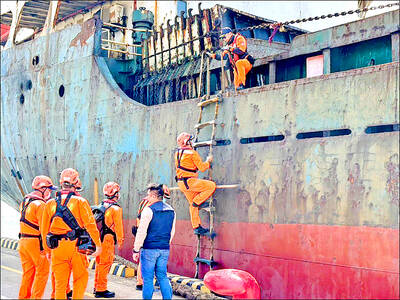The “Place for Friends” is starting to feel lonely.
MySpace, the Rupert Murdoch-owned Web site once synonymous with social networking, is losing popularity and key staff in its biggest troubles since launching five years ago.
The latest figures show that Murdoch, who also owns newspapers around the world, is being beaten in the fight for social networks.
MySpace suffered a drop in visitor traffic last month and is now less than half the size of its younger rival, Facebook.
Three executives recently quit the one-time darling of the Internet and there is speculation its co-founders will follow.
MySpace’s loss of status as the cool place to be is an object lesson in the notoriously fickle Internet, where today’s cultural icon is tomorrow’s passing fad.
From humble origins in 2003, the site led the so-called “Web 2.0” revolution in which users could create their own profile pages and share content with friends.
Murdoch’s purchase of MySpace for US$580 million was seen as a masterstroke as membership continued to soar, with celebrities and politicians joining the craze.
But then came Facebook, founded by Harvard student Mark Zuckerberg, which soon snowballed with an older and apparently more affluent demographic to steal MySpace’s crown.
Gradually newspaper coverage of social networks switched from references to “MySpace and Facebook” to “Facebook and MySpace.”
The rise of Bebo also undermined MySpace’s dominance, while Twitter is among the latest novelties eating into users’ attention spans.
MySpace had 124 million monthly unique visitors last month, a decline of 2 percent, the marketing research company comScore said.
Facebook, by contrast, racked up 276 million unique visitors, an increase of 16.6 percent.
Michael Arrington, co-editor of the influential industry blog TechCrunch, posted: “What was a bad situation in November 2008 is starting to turn outright ugly — Facebook is now well over twice the size of MySpace ... It was less than a year ago that MySpace and Facebook were the same size.”
There are clues behind the scenes that all is not well at Murdoch’s Fox Interactive Media, which runs the site.
Amit Kapur, MySpace’s chief operating officer, resigned after little more than a year in the post to set up a new company.
He will be joined by Jim Benedetto and Steve Pearman, senior vice-presidents of engineering and product strategy.
The exodus comes amid speculation of further departures and rumors that MySpace’s cofounders, Chris DeWolfe and Tom Anderson, could also walk away in October after the end of their contracts, each worth US$30 million over two years.
MySpace is clinging on to a marginal lead over Facebook in the US, but trails badly in Europe.
Nick Thomas, an analyst at Forrester Research, said: “In the last 12 months Facebook has extended its dominance in every territory in Europe.”
he said: “I’m not convinced that it’s terminal for MySpace. The battle isn’t over yet.”

A Chinese freighter that allegedly snapped an undersea cable linking Taiwan proper to Penghu County is suspected of being owned by a Chinese state-run company and had docked at the ports of Kaohsiung and Keelung for three months using different names. On Tuesday last week, the Togo-flagged freighter Hong Tai 58 (宏泰58號) and its Chinese crew were detained after the Taipei-Penghu No. 3 submarine cable was severed. When the Coast Guard Administration (CGA) first attempted to detain the ship on grounds of possible sabotage, its crew said the ship’s name was Hong Tai 168, although the Automatic Identification System (AIS)

An Akizuki-class destroyer last month made the first-ever solo transit of a Japan Maritime Self-Defense Force ship through the Taiwan Strait, Japanese government officials with knowledge of the matter said yesterday. The JS Akizuki carried out a north-to-south transit through the Taiwan Strait on Feb. 5 as it sailed to the South China Sea to participate in a joint exercise with US, Australian and Philippine forces that day. The Japanese destroyer JS Sazanami in September last year made the Japan Maritime Self-Defense Force’s first-ever transit through the Taiwan Strait, but it was joined by vessels from New Zealand and Australia,

CHANGE OF MIND: The Chinese crew at first showed a willingness to cooperate, but later regretted that when the ship arrived at the port and refused to enter Togolese Republic-registered Chinese freighter Hong Tai (宏泰號) and its crew have been detained on suspicion of deliberately damaging a submarine cable connecting Taiwan proper and Penghu County, the Coast Guard Administration said in a statement yesterday. The case would be subject to a “national security-level investigation” by the Tainan District Prosecutors’ Office, it added. The administration said that it had been monitoring the ship since 7:10pm on Saturday when it appeared to be loitering in waters about 6 nautical miles (11km) northwest of Tainan’s Chiang Chun Fishing Port, adding that the ship’s location was about 0.5 nautical miles north of the No.

SECURITY: The purpose for giving Hong Kong and Macau residents more lenient paths to permanent residency no longer applies due to China’s policies, a source said The government is considering removing an optional path to citizenship for residents from Hong Kong and Macau, and lengthening the terms for permanent residence eligibility, a source said yesterday. In a bid to prevent the Chinese Communist Party (CCP) from infiltrating Taiwan through immigration from Hong Kong and Macau, the government could amend immigration laws for residents of the territories who currently receive preferential treatment, an official familiar with the matter speaking on condition of anonymity said. The move was part of “national security-related legislative reform,” they added. Under the amendments, arrivals from the Chinese territories would have to reside in Taiwan for